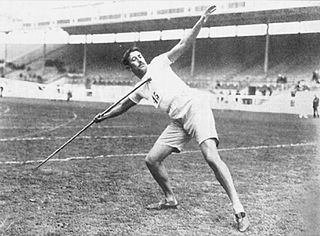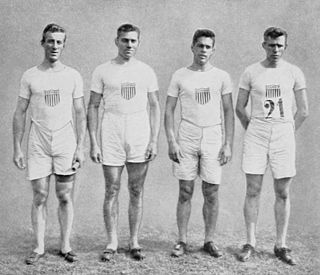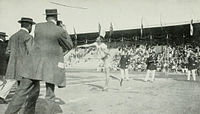
The javelin throw is a track and field event where the javelin, a spear about 2.5 m in length, is thrown as far as possible. The javelin thrower gains momentum by running within a predetermined area. Javelin throwing is an event of both the men's decathlon and the women's heptathlon.

The men's javelin throw was one of six throwing events on the Athletics at the 1908 Summer Olympics programme in London. The javelin was required to be held in the middle. The competition was held on 17 July 1908. 16 throwers from six nations competed. NOCs could enter up to 12 athletes.

The men's 200 metres was a track and field athletics event held as part of the Athletics at the 1912 Summer Olympics programme. It was the fourth appearance of the event, which has appeared at every edition of the Summer Olympics since the 1900 Summer Olympics. The competition was held on July 10, 1912, and on July 11, 1912. 61 runners from 19 nations competed. NOCs could enter up to 12 athletes. The event was won by Ralph Craig of the United States, the nation's third victory in four Games. Another American, Donald Lippincott, took silver. Great Britain earned its first medal in the 200 metres with Willie Applegarth's bronze.

The men's 400 metres was a track and field athletics event held as part of the Athletics at the 1912 Summer Olympics programme. The competition was held on Friday, July 12, 1912, and on Saturday, July 13, 1912. Forty-nine runners from 16 nations competed. NOCs could enter up to 12 athletes. The event was won by Charles Reidpath of the United States, the nation's fourth title in the event. Hanns Braun of Germany took silver, the nation's first medal in the men's 400 metres.

The men's 1500 metres was a track and field athletics event held as part of the athletics at the 1912 Summer Olympics programme. The competition was held on Tuesday, July 9, 1912, and on Wednesday, July 10, 1912. Forty-five runners from 14 nations competed, including the Olympic champion from 1908, Mel Sheppard. NOCs could enter up to 12 athletes.
Urho Pellervo Peltonen was a Finnish athlete who competed mainly in the javelin throw.

Finland competed at the 1912 Summer Olympics in Stockholm, Sweden. The Grand Duchy of Finland was an autonomous part of the Russian Empire at the time, which allowed Finland to compete separately of Russia Russia at the 1908 Summer Olympics due to Finland's special status. During the opening ceremony, Finland's team paraded under the national insignia flag of a Swedish-speaking female gymnastics club in Helsinki. 164 competitors, 162 men and 2 women, took part in 49 events in 10 sports.
Móric "Mór" Kóczán was a Slovak–Hungarian athlete and Calvinist pastor. Specialized for the throwing events, his best results came in the javelin throw, having won five Hungarian championship titles between 1911 and 1918. Kóczán competed for Hungary at the 1908 Summer Olympics and 1912 Summer Olympics. He produced his best performance in 1912 by winning the bronze medal in the javelin throw event.

The men's 10,000 metres was a track and field athletics event held as part of the Athletics at the 1912 Summer Olympics programme. It was the debut of the event, which along with the 5000 metres replaced the 5 mile race held at the 1908 Summer Olympics. The competition was held on Sunday, July 7, 1912, and on Monday, July 8, 1912. Thirty runners from 13 nations competed. NOCs could enter up to 12 athletes.

The men's 4 × 400 metres relay was a track and field athletics event held as part of the Athletics at the 1912 Summer Olympics programme. It was the debut of the event, which along with the 4 × 100 metre relay marked the first relays of equal legs in the athletics programme. The competition was held on Sunday, July 14, 1912, and on Monday, July 15, 1912. Twenty-eight runners from seven nations competed. NOCs could enter 1 team of 4 athletes, with up to 2 reserves.

The men's high jump, also known as the running high jump to distinguish it from the standing high jump, was a track and field athletics event held as part of the Athletics at the 1912 Summer Olympics programme. It was the fifth appearance of the event, which is one of 12 to have been held at every Summer Olympics. The competition was held on July 7, 1912, and on July 8, 1912. Thirty-seven high jumpers from ten nations competed. NOCs could enter up to 12 athletes. The event was won by Alma Richards of the United States, the nation's fifth consecutive victory in the men's high jump. Germany won its second silver medal in the event, after 1904.
The men's pole vault was a track and field athletics event held as part of the Athletics at the 1912 Summer Olympics programme. It was the fifth appearance of the event, which is one of 12 to have been held at every Summer Olympics. The competition was held on Wednesday, July 10, 1912, and on Thursday, July 11, 1912. Twenty-five pole vaulters from eleven nations competed. NOCs could enter up to 12 athletes. It was the second straight Games in which more than 3 medals were awarded in the event. The event was won by Harry Babcock of the United States, the nation's fifth consecutive victory in the event. Fellow Americans Frank Nelson and Marc Wright tied for second and were both awarded silver; normally, this would have constituted a medal sweep. However, bronze medals were awarded to the three men tied for fourth place. This put both Canada and Sweden on the podium for the second consecutive Games and awarded the United States a total of four medals in the 1912 pole vault.

The men's standing high jump was a track and field athletics event held as part of the athletics at the 1912 Summer Olympics programme. It was the fourth and final appearance of the event. The competition was held on Saturday, July 13, 1912.

The men's shot put was a track and field athletics event held as part of the athletics at the 1912 Summer Olympics programme. The competition was held on Wednesday, July 10, 1912. Twenty-two shot putters from 14 nations competed. NOCs could enter up to 12 athletes. The event was won by Pat McDonald of the United States, the nation's fifth consecutive victory in the men's shot put. The American team swept the top three places, the third time in five Games. Ralph Rose took silver, 9 centimetres shy of a third gold medal; he became the first man to win three medals of any color.

The men's discus throw was a track and field athletics event held as part of the athletics at the 1912 Summer Olympics programme. The competition was held on Friday, July 12, 1912. Forty-one discus throwers from 15 nation competed. NOCs could enter up to 12 athletes. The event was won by Armas Taipale of Finland, the nation's first medal in the men's discus throw. Richard Byrd took silver and James Duncan took bronze to continue the United States' podium streak at five consecutive Games.

The men's hammer throw was a track and field athletics event held as part of the athletics at the 1912 Summer Olympics programme. It was the fourth appearance of the event, which had been won all three previous times by John Flanagan. The competition was held on Sunday, July 14, 1912. Fourteen hammer throwers from four nations competed. NOCs could enter up to 12 athletes. The event was won by Matt McGrath of the United States, the nation's fourth consecutive victory in the event. McGrath was the second man to earn multiple medals in the hammer throw. Duncan Gillis of Canada took silver. Clarence Childs of the United States finished third for bronze.

The men's two handed shot put was a track and field athletics event held as part of the Athletics at the 1912 Summer Olympics programme. It was the only appearance of the event at the Olympics, along with the other two handed throws. The format of the event was such that each thrower threw the shot three times with his right hand and three times with his left hand. The best distance with each hand was summed to give a total. The three finalists received three more throws with each hand. The competition was held on Thursday, July 11, 1912. Seven shot putters from five nations competed. NOCs could enter up to 12 athletes.
The men's two handed javelin throw was a track and field athletics event held as part of the Athletics at the 1912 Summer Olympics programme. It was the only appearance of the event at the Olympics, along with the other two handed throws. The format of the event was such that each thrower threw the javelin three times with his right hand and three times with his left hand. The best distance with each hand was summed to give a total. The three finalists received three more throws with each hand. NOCs could enter up to 12 athletes.

The javelin throw at the Summer Olympics is one of four track and field throwing events held at the multi-sport event. The men's javelin throw has been present on the Olympic athletics programme since 1908, being the last of the current throwing events to feature at the Olympics after the shot put, discus throw and hammer throw. The women's event was first contested at the 1932 Olympics, becoming the second women's throws event after the discus in 1928.

Combined events at the Summer Olympics have been contested in several formats at the multi-sport event. There are two combined track and field events in the current Olympic athletics programme: a men's decathlon and a women's heptathlon.

















